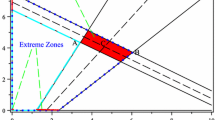Abstract
Given a finite set of alternatives, the sorting problem consists in the assignment of each alternative to one of the pre-defined categories. In this paper, we are interested in multiple criteria sorting problems and, more precisely, in the existing method ELECTRE TRI. This method requires the elicitation of parameters (weights, thresholds, category limits,...) in order to construct the Decision Maker's (DM) preference model. A direct elicitation of these parameters being rather difficult, we proceed to solve this problem in a way that requires from the DM much less cognitive effort. We elicit these parameters indirectly using holistic information given by the DM through assignment examples. We propose an interactive approach that infers the parameters of an ELECTRE TRI model from assignment examples. The determination of an ELECTRE TRI model that best restitutes the assignment examples is formulated through an optimization problem. The interactive aspect of this approach lies in the possibility given to the DM to revise his/her assignment examples and/or to give additional information before the optimization phase restarts.
Similar content being viewed by others
References
C. Bana e Costa, (1993), Les problématiques dans le cadre de l'activité d'aide à la décision. Document du Lamsade no. 74, Université Paris Dauphine.
S. I. Gallant, (1993), Neural Network Learning. MIT Press, Cambridge, Mass.
J. W. Grzymala-Busse, (1992), LERS – a system for learning from examples based on rough sets. In Slowinski R., (ed.), Intelligent Decision Support: Handbook of Applications and Advances of the Rough Set Theory, Kluwer Academic Publishers, Dordrecht.
E. Jacquet-Lagrèze, (1990), Interactive Assessment of Preferences Using Holistic Judgments: the PREFCALC System. In Bana e Costa C., (ed.), Readings in Multiple Criteria Decision Aid, pp. 335–350 Springer-Verlag.
E. Jacquet-Lagrèze, R. Meziani, and R. Slowinski, (1987), MOLP with an interactive assessment of a piecewise-linear utility function. EJOR 31(3), 350–357.
E. Jacquet-Lagrèze and J. Siskos, (1982), Assessing a Set of Additive Utility functions for Multicriteria Decision-Making, the UTA Method, EJOR 10(2), 151–164.
J. G. March, (1988), Bounded Rationality, Ambiguity and the Engineering of Choice. In Bell D. E., Raiffa, H. and Tversky, A. (eds.), Decision Making, Descriptive, Normative and Prescriptive Interactions, pages 33–58. Cambridge University Press, New York, 1988.
Z. Michalewicz and C. Janikov, (1991), Genetic Algorithms for Numerical Optimization. Statistics and Computing 1, 75–91.
R. S. Michalski, (1983), A Theory and Methodology of Inductive Learning. Artificial Intelligence 20 pp. 111–116.
V. Mousseau, (1993), Problèmes liés à l'evaluátion de l'importance relative des critères en aide multicritère à la décision: Réflexions théoriques, expérimentations et implémentations informatiques. PhD Thesis, Université Paris-Dauphine.
V. Mousseau, (1995), Eliciting Information Concerning the Relative Importance of Criteria. In Pardalos P., Siskos Y. and Zopounidis C., (eds.), Advances in Multicriteria Analysis, Nonconvex Optimization and its Applications, pages 17–43. Kluwer Academic Publishers, Dordrecht.
R. Nadeau, J.-M. Martel, and L. Kiss, (1991), Eleccalc: Modelling the Decision Maker's Preferences with ELECTRE II. In Gluckofova D., Loula D. and Cerny M., (eds.), Proceeding of the International Workshop on Multicriteria Decision Making: Methods, Algorithm and Applications, Liblice, Tchecolslovaquie pp. 109–119.
Z. Pawlak and R. Slowinski, (1994), Rough Set Approach to Multi-Attribute Decision Analysis. EJOR 72 pp. 443–459.
J. R. Quinlan, (1986), Induction of Decision Trees. Machine Learning, 1, 81–106.
B. Roy, (1996), Multicriteria Methodology for Decision Aiding, Nonconvex Optimization and its Applications, Kluwer Academic Publishers, Dordrecht.
B. Roy, (1989), Main Sources of Inaccurate Determination, Uncertainty and Imprecision in Decision Models. Mathematical and Computer Modelling, 12 (10–11).
B. Roy and D. Bouyssou, (1993), Aide multicritère à la décision: méthodes et cas. Economica, Paris.
B. Roy and Ph. Vincke, (1984), Relational Systems of Preferences with One or More Pseudo-Criteria: Some New Concepts and Results. Management Science, 30(11) pp. 1245–1254.
Y. Siskos and D. Yanacopoulos, (1985), UTA STAR – An Ordinal Regression Method for Building Additive Value Functions. Investigacao Operational, 5, 1985.
R. Slowinski, (1991), Interactive Multiobjective Optimization Based on Ordinal Regression. In Lewandovski A. and V. Volkovich, V., (ed.), Multiobjective Problems of Mathematical Programming, volume 351 of LNEMS, pages 93–100. Springer-Verlag, Berlin.
R. Slowinski, (1992), Intelligent Decision Support: Handbook of Applications and Advances of the Rough Set Theory. Kluwer Academic Publishers, Dordrecht.
S. M. Weiss and C. A. Kulikowski, (1991), Computer Systems that Learn, Morgan Kaufmann, San Mateo, CA.
D. Yannacopoulos, (1985), Mise en place et expérimentation d'un SIAD multicritère: le système MINORA. thèse de 3ème cycle, Université de Paris-Dauphine.
W. Yu, (1992), Aide multicritère à la décision dans le cadre de la problématique du tri: concepts, méthodes et applications. PhD thesis, Université Paris-Dauphine.
W. Yu, (1992), ELECTRE TRI: Aspects méthodologiques et manuel d'utilisation. Document du LAMSADE No. 74, Université Paris-Dauphine.
Author information
Authors and Affiliations
Rights and permissions
About this article
Cite this article
Mousseau, V., Slowinski, R. Inferring an ELECTRE TRI Model from Assignment Examples. Journal of Global Optimization 12, 157–174 (1998). https://doi.org/10.1023/A:1008210427517
Issue Date:
DOI: https://doi.org/10.1023/A:1008210427517




